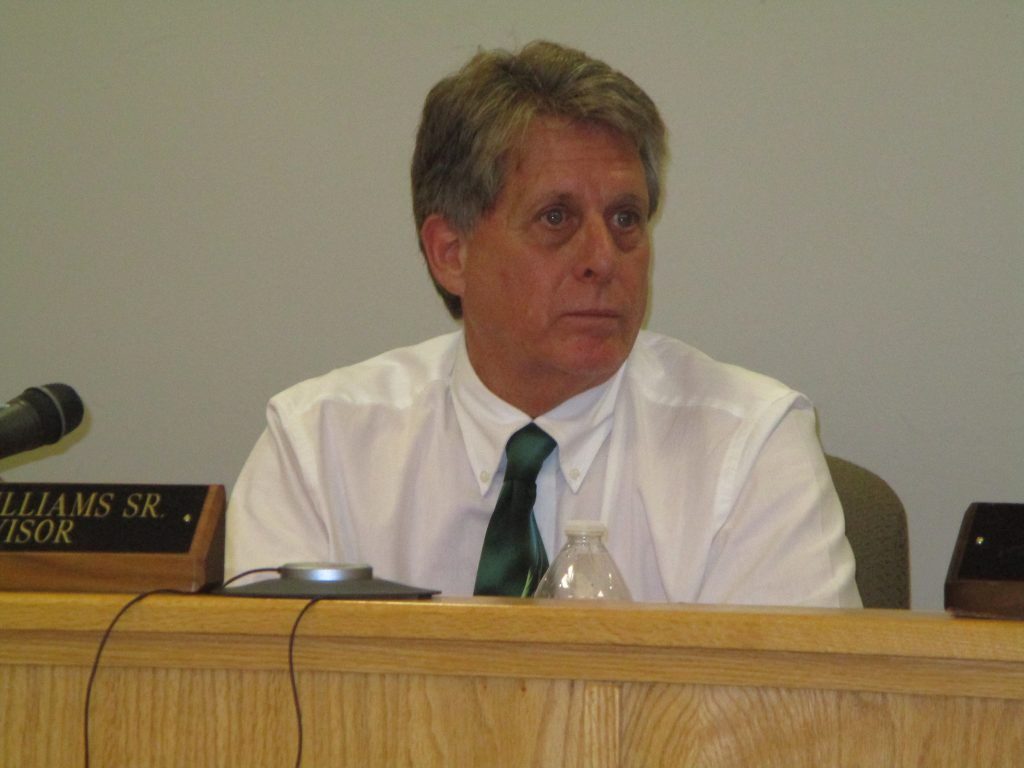Cell Tower Proposal Hotly Debated in Patterson

A proposal from the Metropolitan Transit Authority to construct a cell tower on the site of the Patterson Recycling Center on Cornwall Hill Road sparked heated debate at the Aug. 8 Town Board meeting.
Supervisor Richard Williams said last week the MTA has been considering sites in town for a cell tower to improve its “critical public communication.”
The MTA had considered placing a 170-foot-tall cell tower on Route 164, Williams said. But Williams said he and Putnam County Legislator Ginny Nacerino opposed the project because it would have been located in a residential neighborhood. The MTA would not agree to a proposal from Nacerino and himself to move the location of the tower further back on Route 164 to reduce the impact on neighboring homeowners, Williams said.
Williams said he and Nacerino subsequently proposed that the MTA construct multiple towers at lower heights off Route 312 in Southeast or at two sites on the Patterson Recycling Center property.
Williams said he wanted no additional cell tower in town. “If we had our way there wouldn’t be anymore cell towers in the Town of Patterson,” he said. “Many of us feel that they are blight on the landscape, myself included.”
But more towers are needed because of “the technology everybody is using today,” Williams said. Additional cell tower applications will be submitted for cell towers in the near future, he predicted.
The tower would be operated by Wireless Edge. John Arthur, president and CEO of Wireless Edge, told the town board the height of the proposed cell tower would be 166 feet, Verizon, which had previously been seeking to operate the tower, had considered a height of 160 feet, Arthur said. Wireless Edge wants the tower to be 166 feet high because the additional six feet would allow for additional antennas to be placed on the tower, he said.
Because the MTA is a state authority they can bypass local zoning, Jordan Fry, an attorney working on the project, told the Town Board. “It’s the MTA who can really drive where things can go,” he said. Wireless Edge is proving the infrastructure for the cell tower, Fry said in response to a question from Deputy Supervisor Charles Cook.
If the MTA did not seek to place the cell tower on the recycling center site it would be constructed on Route 164, Arthur said.
Nacerino told the town board she and Williams have been working with the MTA for the past few years on where to locate their proposed cell tower. A potential site she and the town had asked the MTA to consider is the 145 acre parcel owned by LAPCORS, LLC at 629 Route 311, which has an application for a paintball and recreation center that is being reviewed by the Planning Board. The MTA instead has chosen the recycling center site, she said.
The MTA needs a cell tower to improve communications, including responding to 911 calls, Nacerino said. The Route 164 location would not be appropriate because it would “literally be at someone’s front door” and destroy the homeowner’s equity in the property, as well as that of neighboring homeowners, she said.
Nacerino said she understands that no one in Patterson wants another cell tower in town.
A resident, who said she was a member of the Friends of the Great Swamp, said she supported the placement of the new cell tower at the recycling center property. Her organization has been monitoring the fall migrations near the trestle bridge near the train tacks off Route 164 for the past seven years, she said. Up to 3,000 ducks have migrated by the bridge every fall and Friends of the Great Swamp does not want the cell tower to be placed on Route 164 as had been previously considered by Metro-North. Having a single cell tower on the recycling center property was preferable, she said.
While support was expressed for placing a new cell tower on the recycling center site, the proposal was sharply criticized by resident Bruce Major. “I’ve speaking on this issue for over two years,” Major said. A more appropriate location for the cell tower would be the LAPCORS site, he said.
Williams told Major that the LAPCORS was not a viable alternative to the recycling center location. “The town board doesn’t have the authority right now to approve a site plan for a cell tower, nor, under our zoning code, do we have the ability to approve variances that will allow that tower to go in at LAPCORS,” Williams said.
Williams said he did not want the town board to change zoning code to allow cell towers to be built on any location in town.
Major said he was frustrated with the process for the MTA to obtain approval for the site of its proposed new cell tower. “Government can do what government wants to do, but we the folks can’t do necessarily what we want to do,” he said.
Major said if the MTA was made aware that the town board wanted the cell tower to be placed at the LAPCORS property the agency could be convinced that was the right site.
MTA responds
An MTA official, who did want to be identified, said last week the decision on whether to approve or not approve the site of the cell tower at the recycling center was up to the town board because it would be located on town property.
The new cell tower was needed for the communications system used by the MTA’s Police Department for the maintenance of the safety and security of the area, the source said, adding the MTA has been in discussions with the town about a new safety system for more than three years.
